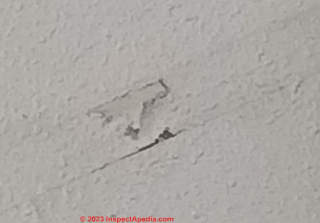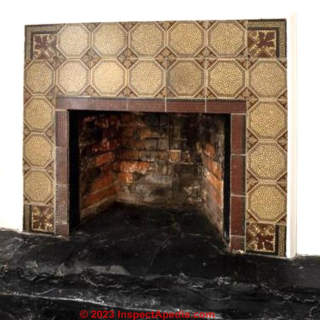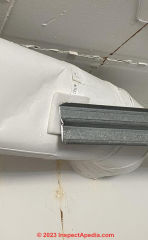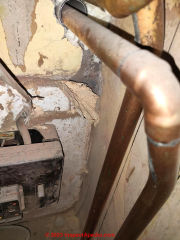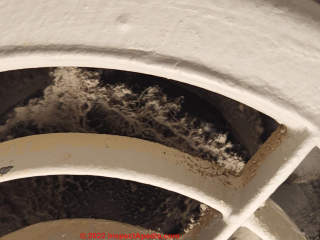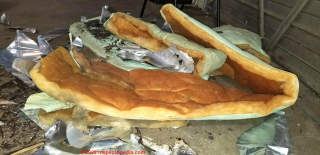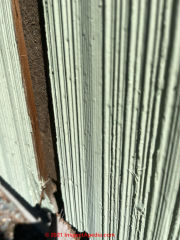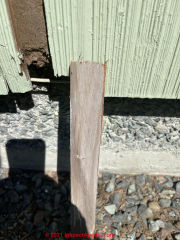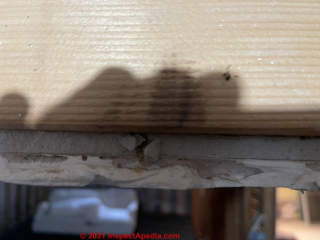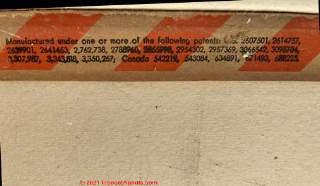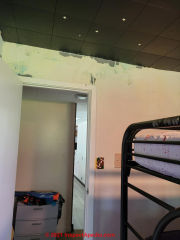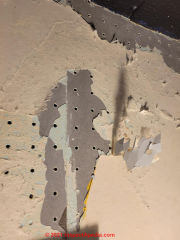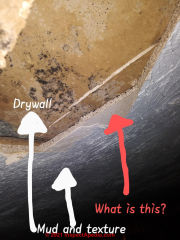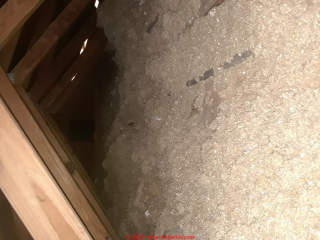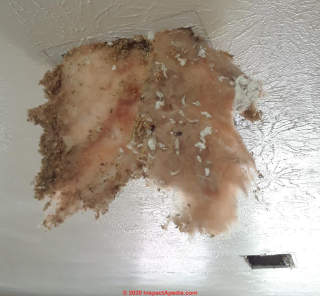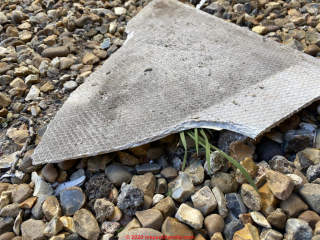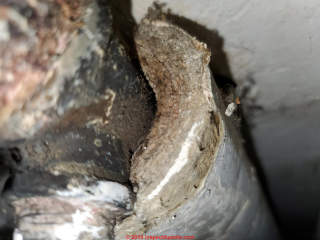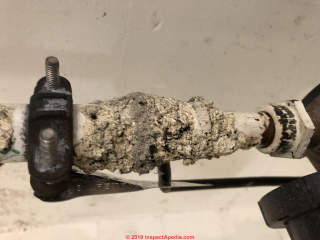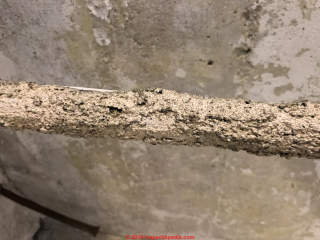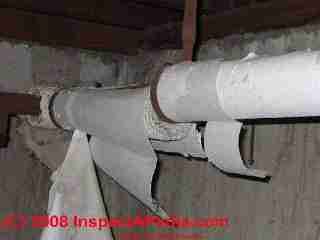 Asbestos Identification in Buildings FAQs
Asbestos Identification in Buildings FAQs
Q&A: How to find & identify asbestos-containing materials
- POST a QUESTION or COMMENT about what building materials may contain asbestos, visual identification of asbestos-containing materials in buildings, and possible asbestos material identification by testing, use, age, appearance
FAQs about how to recognize asbestos in buildings.
This article series provides basic guidance, a photo guide, and a complete list of asbetsos-containing materials as well as dates or history of their use: this information can be used to identify most asbestos-containing materials (or probable-asbestos) in buildings by simple visual inspection.
InspectAPedia tolerates no conflicts of interest. We have no relationship with advertisers, products, or services discussed at this website.
- Daniel Friedman, Publisher/Editor/Author - See WHO ARE WE?
Q&A on Recognizing Asbestos Hazards in Buildings
These questions and answers about how to recognize asbestos containing materials, asbestos suspect materials, or items that should be treated as PACM - Presumed Asbestos Containing Materials, were posted originally
at ASBESTOS IDENTIFICATION IN BUILDINGS - home - be sure to check the guidance given on that page.
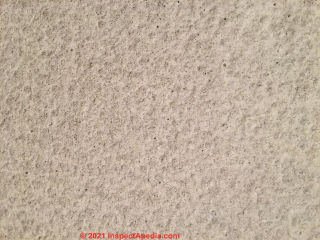 While a lab test is required to identify certain asbestos materials or to identify the type of asbestos, many asbestos-containing materials can be recognized by a combination of simple visual inspection and sometimes also knowing the material's age.
While a lab test is required to identify certain asbestos materials or to identify the type of asbestos, many asbestos-containing materials can be recognized by a combination of simple visual inspection and sometimes also knowing the material's age.
And asbestos can smilarly be ruled-out in other materials.
On 2022-09-03 by InspectApedia-911 (mod) - flat roofs likely to have contained asbestos products?
@Margo,
Yes. in the index to related articles given on this page you will find a number of articles on Roofing Products including asbestos used in felt paper that was commonly applied for built up roofs on residential as well as commercial buildings, and Asbestos and Roofing mastics and flashing cement.
That's not something to panic about as those materials are not highly friable unless there's a demolition in progress.
On 2022-09-03 by Margo
Do you have any knowledge as to whether 1950s residential homes with built-up roof flat roofs likely contained asbestos products (felt or tar, etc). I've found references to asbestos products common in commercial flat roof buildings, but don't know if it was as common in single family homes.
Home in question was built in 1952 in Florida. Flat roof with tar and gravel. This is a former home, so do not have ability to test.
On 2022-08-23 by InspectApedia-911 (mod)
@Brian,
In what country and city?
On 2022-08-23 by Brian
Popcorn ceiling at my work. It's a hotel and it's on almost every ceiling. I think it was finished being built in 1990. Should I be concerned working underneath it?
On 2022-08-08 by InspectApedia-911 (mod)
@Suzanne M.,
Possibly, yes, likely, no.
On 2022-08-08 by Suzanne M.
Could this oddly formed painted hearth contain asbestos?
On 2022-07-19 by InspectApedia-911 (mod)
@Eric,
Not that we can say from a photo.
On 2022-07-19 by Eric
Is there any indication of asbestos on this duct and is the damage created by the garage door arm enough to disturb it? This home was built in 1952 and does have an asbestos flue.
On 2022-06-08 by InspectApedia-911 (mod) - Asbestos Flooring Hazard Reduction
@Mayur, if most of the floor tiles are securely bonded then it would make sense to Simply fill in the few areas where you've lost tiles and then cover the entire flooring with underlayment and then a new flooring material of your choice..
In the INDEX TO RELATED ARTICLES you will find an article on
Asbestos Flooring Hazard Reduction
that gives various options
On 2022-06-08 by Mayur
I found out that in the basement of my house there is vinyl tiles glued down on concrete floor. I sent in sample of tiles from different spots for asbestos testing. The result came back negative for tiles but the black mastic came back positive with 6% asbestos.
What are my option to cover the floor? ( the tiles are in good condition except few areas where they chipped)
1. Can I use perfect primer over it to encapsulate and then use click lock vinyl plan flooring?
2. Should I remove the tiles and prime the black mastic and then put the vinyl plank flooring?
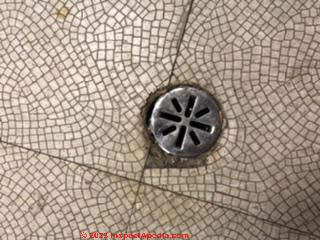
On 2022-06-08 by InspectApedia-911 (mod)
@David wild,
If you try using the on Page search box to search for the phrase
Asbestos in fiberboard sheathing
You'll find what we know about this topic and your question that I think may have been posted on another page.
On 2022-06-08 by David wild
I must point out that a lot of the dust is from drilling through a brick wall with old yellow plaster above the panel
On 2022-04-28 by Inspectapedia Com Moderator - dust clogging in air registers needs maintenance and cleaning
@Brad,
Your photos show lots of dust clogging and deposited on an air supply register.
It may be that the building air has a high dust particle load or that the HVAC filters are not being maintained. And the duct system and air handler would doubtless benefit from a professional cleaning (note that not all types of ductwork CAN be cleaned.
Nothing in your photos raises an asbestos concern except perhaps a very subtle and very indirect clue: thickness of paint on the register cover may indicate that the building is an old one - possibly dating from an era when asbestos was used in many products.
But START by discussing your concerns with your doctor, and listen to her advice. You might ask if the doc thinks that dust levels in your environment could be a cause or aggravation of your health complaints.
On 2022-04-28 by Brad
Help I just moved into this apartment and ny health is deteriorating
On 2022-02-16 by Inspectapedia Com Moderator - fiberglass insulation identification
@Steven,
That sure looks like fiberglass insulation - PLEASE take a look at
FIBERGLASS INSULATION IDENTIFICATION & PROPERTIES
Insulation is virtually always hand cut during its installation.
On 2022-02-16 by Steven
Hello. Does anyone recognize this insulation? It was used to insulate my basement garage. The lining is similar to a light teal combined with off white. Oddly enough, all of this insulation was installed with the lining against the subfloor, which I haven't seen before.
One more item of note, the insulation appears to be all hand-cut. I assume the lined side is vapor barrier since it was installed facing the subfloor of the heated area of my home.
The house was built in 1972 and I haven't seen any identifying markings. Thank you!
On 2021-12-30 by Inspectapedia Com Moderator
@Asbestos in walls and ceiling in 1931 house?,
We have too little information to keep speculating here.
Companies vary considerably in how they treat asbestos-suspect material encountered during building repairs depending on local laws and level of training and expertise; some contractors may proceed willy-nilly with nary a care while others may stop the job dead, insist on testing the suspect material, and if ACM is confirmed may insist on customer hiring an asbestos abatement professional before proceeding with their repair.
On 2021-12-30 by Asbestos in walls and ceiling in 1931 house?
@Inspectapedia Com Moderator, thank you! The ceiling looks like painted fiberboard but the walls not, more like plaster.
Wondering if under that ceiling board could be still some asbestos or asbestos insulation, or something under roof and whats the chance the water dripping from ceiling and walls all over bed and stuff could contain asbestos fibers and what to do in this case. Any idea?
And any idea how companies these days treat asbestos when fixing leak, do they really are careful about it or just want to do the job so will not even try to test it? Is there high chance asbestos will be relased after the water will dry and if they do any cutting of the ceiling/walls without testing? Is better to leave the house? Thanks.
On 2021-12-30 by Inspectapedia Com Moderator - Asbestos in walls and ceiling in 1931 house?
@Asbestos in walls and ceiling in 1931 house?,
Best bet would be to take a look at
DOES THIS MATERIAL CONTAIN ASBESTOS? - 5 easy questions to tell if a BUILDING MATERIAL probably contains asbestos -
and
ASBESTOS in DRYWALL
OR if that's a fiberboard ceiling or wall covering
see
FIBERBOARD SHEATHING ASBESTOS CONTENT
NOTE:
Asbestos is safe and legal in homes as long as it's not being damaged, or made into a dust hazard such as by demolition, chopping, grinding, sawing, etc. - paraphrasing the US EPA
On 2021-12-30 by Asbestos in walls and ceiling in 1931 house?
In house 1931 California, some parts are wood but some parts look like regular nonwood walls, where everywhere could be asbestos? In walls or roof too? There is a leak on the ceiling and walls the water is dripping on things, could even the water contain asbestos?
And when they come to fix it and decide to tear it apart, could there be asbestos in walls and ceiling? Do all companies go by the protocol and will make sure no asbestos will be released to air when fixing leaks? Or is it better to leave the house?
We are renting so cant choose the company. Thanks!
On 2021-09-09 by inspectapedia.com.moderator (mod)
@Anonymous,
Start with
DOES THIS MATERIAL CONTAIN ASBESTOS?
https://inspectapedia.com/hazmat/DIY-Asbestos-Material-Test.php
On 2021-09-08 by Anonymous
@inspectapedia.com.moderator, what about dry wall. Should I have them tested if removing wall?
On 2021-09-08 by inspectapedia.com.moderator (mod)
@Reggie,
Far safer and less expensive to simply cover the existing floor with a new layer of material.
On 2021-09-08 by Reggie
Is it better to floor over an asbestos floor or have it taken out by licensed company ?
On 2021-09-06 by mak.church (mod)
@Rafael,
Yes, I believe so. You could also look more closely at an unpainted edge or where the material is penetrated or cut, or at the back of a shingle if one is available.
There are no other siding materials that look exactly like that, though there are both fiber cement and plastic shingles with similar patterns. They don't have those close, deep, vertical, grain details.
Also see FIBERBOARD SHEATHING IDENTIFICATION
On 2021-09-06 by Rafael
@mak.church, These are clearly cedar shingles correct? the house next door has cement. The backing also looks like some type of fiberboard.
That’s a cut out of it. yep here is the back. Cedar. And is that backing a wood composite ? Looks that way
On 2021-09-05 1 by inspectapedia.com.moderator (mod) - cover asbestos-suspect materials if possible; leave undisturbed; or have the material tested
@SteveB,
If you are covering asbestos suspect materials that's generally a good practice; don't disturb them.
Asbestos pipe insulation was usually wrapped in linen or a similar cloth but of course someone could later have covered it with further encapsulant or a protective cover; often if we can see an end view of the material it will be obvious.
Plaster coatings might contain asbestos - please take a look at the article I mentioned previously.
On 2021-09-05 by SteveB
last thing, if I put a ceiling right over this is that the best way to handle it?
in the first pic that's a pipe
it's a plaster like material that was plastered on. Also, not really pipe insulation, but a plater ceiling that is plastered onto pipes
On 2021-09-05 by inspectapedia.com.moderator (mod)
@StevieB,
From the photos alone I doubt that anyone can make a useful guess at whether or not that material contains asbestos. We recently added documentation asbestos-board ceiling and wall panels, sold with beveled edges, used in Australia and other U.K. areas in those decades.
But answering the questions at DOES THIS MATERIAL CONTAIN ASBESTOS
you can make a reasonable guess, or decide on having the material tested.
On 2021-09-05 by StevieB
What about this plaster looking section?
Two questions. The first pic is a section where I’ve already confirmed the under piece is not contaminated. What about the piece over it (white piece). Someone said plaster.
On 2021-09-03 by inspectapedia.com.moderator (mod) - absence of evidence (of asbestos) is not evidence of absence
@jack,
The way you can think about this question is the following:
A patent disclosure that happens to be for an invention that involves a mix of ingredients will, in that case, usually mention the ingredients; so in that case if asbestos is an ingredient it may be mentioned.
But nobody can promise you what a 60 year old patent disclosure must or must not mention.
The presence of the word "asbestos" among ingredients in a material would be evidence of its use.
The absence of the word asbestos would not be a promise of its absence.
Absence of evidence is not evidence of absence.
Watch out: for anyone who is anxious about any topic, such as a possible environmental hazard, that anxiety itself can be both a health hazard and a financial hazard. When one consults someone with experience and asks a question, the consultant may offer her best answer but may point out that certainty is often not possible.
If you continue to press that person it can get very expensive as you force them to give you advice to spend as much of your money to reduce their risk.
See details at https://inspectapedia.com/home_inspection/Other_Peoples_Money.php OTHER PEOPLE's MONEY
On 2021-09-03 by @jack
@inspectapedia.com.moderator, sorry. If asbestos was used would it be in the patent ?
On 2021-09-03 by inspectapedia.com.moderator (mod)
@jack,
Sorry I don't understand the question. Why would a patent pose a problem?
To be clear, I scanned the patents for the word "asbestos" as that's at the heart of your question about identifying this drywall, and I scanned them to identify the probable manufacture and the possible oldest-date that the drywall might have been made.
In turn that tells us whether or not it was manufactured before asbestos use was ended in the U.S. (ca 1986).
But the patents themselves - ?
On 2021-09-03 by inspectapedia.com.moderator (mod) - identify drywall and its age from patent data
@jack,
We researched all of those patent numbers (other readers note: please don't expect us to always do this as it's quite a bit of work)
that I will list below;
From the patent numbers it's reasonable to assume that your drywall was a National Gypsum product made in or after 1967 as that's the youngest patent date among those data points.
Bottom line: we can be reasonably confident this is a National Gypsum drywall product made during years when asbestos was used in some drywall and in some drywall joint compound products.
None of the U.S. patents themselves mention the word "asbestos" in their description. We didn't read through the Canadian patent documents as those are more tedious to access.
Details are below:
US Patent
2607501 Jeffey Alberta, National Gypsum Co. 1952 Apparatus for stacking wallboard panels and the like
2614757 1952 Apparatus for continuously delivering plastic cementitious material to a moving molding surface
2639901 Robert R. Teale National Gypsum 1953 Pin mixer
2641453 Teale National Gypsum 1953 Pin mixer
2762738 Teale National Gypsum 1956 Wallboard and method for producing the same
2788960 Skinner et als, National Gypsum 1957 Continuous calcination process and apparatus therefore
2855998 John A Einhiple, National Gypsum Co., 1958 - 1962 Continuous web perforating machine
2954302 Gorman, National Gypsum, 1960 Water repellent paper and sheathing board
includes citations of
US2373914A
1945-04-17
Method of forming asbestos papers with gel binders - Assignee: Johns Manville Corp.
and
US3985610A
1976-10-12
Water-resistant asbestos-cement - Assignee IBM
2957369 Einhiple, National Gypsum Co. 1958, Continuous web perforating machine
3066542 Einhiple, National Gypsum Co. 1958, Continuous web perforating machine
3098784 Gorman, national Gypsum, Process of deinking printed paper
3307987 D Bieri 1967 National Gypsum Co. Process of making a gypsum wallboard having a decreased starch content in the gypsum core
3343818 Henry F. Plemos, marvin D.S. Fiels, to National Gypsum 1967 Process for making gypsum board
3350257 Hourigan & Shull, to National Gypsum Co. 1960,1967 Plastic-covered gypsum wallboard
Canadian Patent
542219 Seufert & Skinner, to national Gypsum Co. 1957 CONTINUOUS CALCINATION PROCESS AND APPARATUS THEREFOR [no text available]
543084 Teale, National Gypsu, 1957 WALLBOARD AND METHOD FOR PRODUCING THE SAME
634891 Gorman, National Gypsum, 1962 WATER REPELLENT PAPER AND SHEATHING BOARD
671493 Gorman, National Gypsm, 1963, Process of De-inking printed paper
688225 Bieri, national Gypsum, 1964 GYPSUM WALLBOARD
On 2021-09-02 by @jack
@mak.church, thank you. I see another stamped marking but it's behind a 2x4. will try to make that out as well
On 2021-09-02 by jack
do these patents pose a problem?
On 2021-08-14 by inspectapedia.com.moderator (mod)
@Michael,
Thanks for those added details. Indeed I have found myself that's sometimes flashing types don't bond well to old surfaces, so we would occasionally staple the upper edges or sides in place.
On 2021-08-13 by Michael
@inspectapedia.com.moderator, One thing to note about the material. It was not clear if it was peel and stick. It was definitely stapled and then on top of it there was some white residue adhesive that was crumbling (could have been paint too) and then the sill was placed on and nailed. On the outside where the window flange was, it was just this material (no white residue, hence why I suspect paint). The picture that I took was likely the backside (clean part) of the material.
On 2021-08-13 by inspectapedia.com.moderator (mod) - black rubbery weatherstripping asbestos?
@Michael,
If you're asking whether that black rubber-plastic-leather like material is asbestos- that seems pretty unlikely; This looks like a type of flashing membrane.
If it's an adhesive backed flashing tape, that's not an asbestos product:
See
FLASHING MEMBRANES PEEL & STICK
On 2021-08-13 by Michael
We had our window sills replaced and this was under the old ones. It is rubber/leather like, black, stapled in place and slightly difficult to rip by hand (harder than paper, easier than leather).
The house was built in 1981.
[Photo above]
On 2021-08-03 by inspectapedia.com.moderator (mod) - don't confuse perforated acoustic ceiling tiles (may contain asbestos) with hardboard pegboard
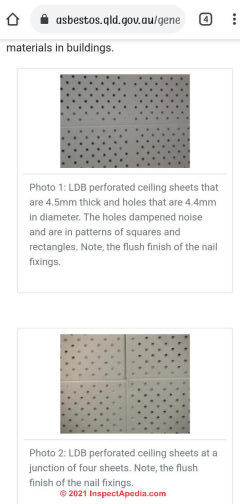 @kaymbuck,
@kaymbuck,
Did you notice that the hole pattern in your wall board is completely different from the hole pattern in the ceiling "sheet" examples that you gave.
Acoustic ceiling tiles with staggered perforations are entirely different from aligned hole patterns in hardboard pegboard.
And your board the holes are in a rectangular layout and in the product photos that you included the holes are staggered.
Also take a look at the material itself and compare that to the hardboard and fiber board examples in the link that I recommended earlier. We'll know more when we can see more of your wall board
But thank you for the references , I'm studying them further.
I'm pretty sure that your "perforated asbestos sheets" in your screen clip (shown here) are improperly-named in the image and that what that image actually shows not "sheets" but rather perforated acoustic ceiling tiles, not hardboard nor pegboard.
On 2021-08-01 by kaymbuck
@inspectapedia.com.moderator,
So this is the main site that has pictures similar to what my wall looks like.
https://www.asbestos.qld.gov.au/general-information/low-density-asbestos-fibre-board/low-density-board-photo-gallery
Let me know you think..I haven't taken it off the wall to see the back because I didn't know what it was. I just ordered an asbestos test kit.
On 2021-08-01 by inspectapedia.com.moderator (mod) - Some AIB perforated wall boards found online do contain asbestos"
@kaymbuck,
Thank you so much for the discussion;
about
"AIB perforated wall boards that I found online which do contain asbestos"
I need to research that further and would be grateful for any references you have;
In your photo that I thought was a bit bleached-out, that looked like HDF or MDF hardboard pegboard; can we see its back?
Take a look at
HARDBOARD MASONITE™ & OTHER BRANDS https://inspectapedia.com/structure/Masonite-Definition-History-Composition.php
HARDBOARD Masonite™-like INGREDIENTS https://inspectapedia.com/structure/Hardboard-Masonite-Asbestos.php
MASONITE & HARDBOARD CEILING & WALL COVERINGS https://inspectapedia.com/interiors/Interior_Wall_Covering_Choices.php#Hardboard
On 2021-08-01 by kaymbuck - to some AIB perforated wall boards found online do contain asbestos
@inspectapedia.com.moderator, I've just never seen this pegboard type wall that was behind the wallpaper...it looked similar to some AIB perforated wall boards that I found online which do contain asbestos
On 2021-08-01 by inspectapedia.com.moderator (mod)
@kaymbuck, vinyl what, wallpaper?
That's not an asbestos material.
On 2021-08-01 by kaymbuck
Just checking because the house was built in 1963 and the wallpaper they painted over looks like the old vinyl
On 2021-08-01 by inspectapedia.com.moderator (mod) - could this perforated hardboard covering or board itself be an asbestos product?
@kaymbuck,
That looks like pegboard which is a wood or cellulose product also referred to as hard to board. It looks as if someone painted over it and then glued wallpaper on top of that.
On 2021-08-01 by kaymbuck
Could this be asbestos? After removing the border in my son's room the wall started peeling off and it looks like some type of pegboard underneath...our home was built in 1963
On 2021-01-08 by (mod) - asbestos very unlikely in any wall spray coating applid in 2007
PC
You don't give country and city of location, but in most countries, nobody was using asbestos in spray coatings in 2007; most discontinued use of asbestos decades before.
Keep in mind, of course, that no one can tell you, from a photo alone, what are the constituents of a spray-on coating.
On 2021-01-08 by pcguy65
Our condo was built in 2007. We are the original owners. When it was being built we explicitly told the builder (Pulte) NOT to spray the sand-paint mixture on the cast cement walls. They did it anyway & didn't tell us until after it was done even though we told them not to well before it was applied See picture.
Does this spray-on coating contain asbestos?
[Photo above]
On 2020-12-05 - by (mod) -
Cat:
As you requested we have deleted your question, photo, and our reply. - Ed.
On 2020-12-05 by cat
could you please delete the comments by cat on asbestos?
On 2020-10-21 - by (mod) -
Top coat of plaster on plaster board base.
I think I see some mold in the wall cavity but can't be certain from your photo.
Try the on-page search box to find our article on MOLD APPEARANCE - WHAT MOLD LOOKS LIKE
On 2020-10-21 by Amanda
On 2020-08-24 by Chrissy
I need help identifing asbestosis I have a picture of what maybe it, if someone can help I would appreciate it
On 2020-06-01 1 by Tim
One more for you....is this black mold?
On 2020-05-31 by Adam - white efflorescence in 1970's Ontario town home
I'm replacing the wood paneling in my basement with drywall, and in doing so, saw there was a stucco spray like substance degrading behind the wall. (I can tell it's a spray because they oversprayed on the cross beams
Am I at any risk here, or can I just shopvac the chippings, and finish patching over?
My townhome was built in the 1970s, Ontario Canada
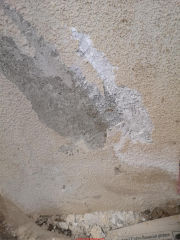
On 2020-05-29 by - by (mod) - cellulose insulation is not asbestos
Tim
That looks like blown-in cellulose insulation, often made of chopped newsprint, treated with a fire retardant borate.
See if you can look closely at some fragments; sometimes we see actual letters and characters of newsprint.
On 2020-05-29 by Tim
How about up here? I'm working on some old buildings just not sure.
On 2020-05-29 15:23:02.888373 - by (mod) -
Tim: I see fiberglass insulation with some white debris on it
On 2020-05-29 by Tim
Wondering if this may contain asbestos?
On 2020-05-14 - by (mod) -
That looks like a fiber cement siding or shingle.
Yes, depending on its age it could contain asbestos.
It's cementious. Not friable. Bag it and toss it as construction debris.
On 2020-05-14
by Requesting assistance
Hi. Is it possible that this could be asbestos? Found on a neighbouring property. Thanks
On 2020-05-13 - by (mod) - laws that would allow me to access records of possible test for asbestos my past landlord
I'm not sure, Eugene.
The disclosure idea is a lead; Perhaps you can find public records of sale, but I'm doubtful.
On 2020-05-12 by Eugene
Thanks. I anticipated that might be the case. Is it likely to find asbestos in such a location? Personally I would have never imagined there might be asbestos used in such a place, but I am no expert by any means. I heard IL banned asbestos in 1971 for fireproofing and insulation.
On 2020-05-12 - by (mod) -
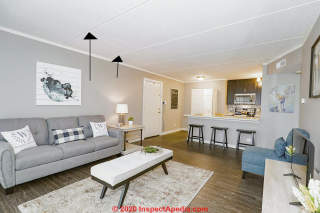 Eugene
Eugene
For a reliable and complete answer to your question I think you would need to consult with an environmental lawyer. However my general opinion is that the answer to your question is no.
Most asbestos tests are performed as a private service. Only if the asbestos testing was part of a public record would you expect that it should be accessible to someone in the future.
On 2020-05-11 by Eugene
Hi, Are there any laws that would allow me to access records of possible test for asbestos my past landlord may have done in their property?
I recently learned that asbestos was sometimes added to concrete. A couple of years ago I lived in an apartment as shown in the picture (sorry about the quality). These are concrete panels with gaps between them filled with some material.
Upon returning home one day I discovered dust that had fallen on my belonging from the seams in the ceiling between the panels. I never got a definitive answer from from the landlord whether there was asbestos in the building and I didn’t think do to testing on the dust at the time. The property was built allegedly in 1974.
As far as I know the apartment complex was resold in 2016 and I’ve seen information stating that by IL law sellers are required to disclose presence of asbestos in the sold property.
On 2019-12-23 - by (mod) - Limestone wall paint in 1890 home may contain asbestos
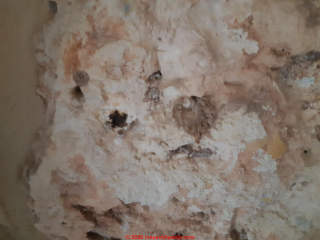 M
M
I can't say what is the material in your photo; if there have been leaks into or through the wall it may be efflorescence or mineral salts left behind.
On 2019-12-22 by M
I live in a 130 year old house. The walls are made of limestone and i do not believe they have insulation in them. There are some placed where there are brown sticks sticking out of the wall.
They seem like old pieces of wood but i am unsure.
In my country (Malta), we used to use crysotile asbestos but i do not know if we used amosite . What is your opinion
Comment: Possible asbestos in fibreboard / sheeting, at old pub 1888 in the Riversdale Hotel
This is from the Riversdale Hotel, - Source: Riversdale Hotel, 277 Auburn Road - Hawthorn East 3123, Melbourne Australia
The photos I have taken are in the Utility room [toilets] where I noticed this exposed substrate board, with some writing on it,
Do Not Breathe Dust Wear Respirator
I thought it was something that you don't see very often these days as most places are renovated and/ or covered up. - Marc Joshmar - Melbourne
Reply:
I agree that the warning imprinted on this material is not often seen. Zooming in on your photo to see the edges of the material and the mounting screws suggest that this is either a type of fibreboard or an asbestos-cement board, though without a closer look, sorry to say I can't even rule out gypsum board or Gyproc.
See details of this conversation
at ASBESTOS PRODUCTS in AUSTRALIA
On 2019-12-23 by (mod) - Effloresence - mineral salts on a masonry wall in Malta - not asbestos
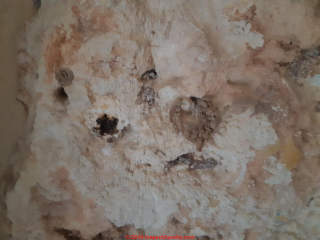 M
M
I can't say with absolute certainty what is the material in your photo; if there have been leaks into or through the wall it may be efflorescence or mineral salts left behind.
The image is a bit blurry but that's what it looks like to me.
See EFFLORESCENCE & BROWN DEPOSITS
On 2019-12-22 by M
I live in a 130 year old house. The walls are made of limestone and i do not believe they have insulation in them. There are some placed where there are brown sticks sticking out of the wall.
They seem like old pieces of wood but i am unsure.
In my country (Malta), we used to use crysotile asbestos but i do not know if we used amosite . What is your opinion
I live in a very old house (around 130 years), the walls of the house are rather crumbly as they are made of limestone, however they have these brown bits popping out which feel like old pieces of wood.
I worry that they might be amosite however they do not feel brittle but rather they feel hard.
The country i live in, which is Malta, used to use white asbestos but i dont know if they used to use amosite.
What do you think it could be
On 2019-11-17 by (mod) - fibrous pipe insulation probably not asbestos
Em
The photo is a little blurry so I'm not sure exactly what we're looking at but as far as I can tell it looks a lot like mineral wool.
The most common asbestos pipe insulation in cross section or the ends of the section of the insulating material it looks like a kind of grayish white corrugated cardboard shaped material
On 2019-11-17 by EMWhit
Hello,
I live in a 1920s apt building. There are some exposed pipes in one of our closets next to the bathroom. Worried the insulation is asbestos, especially since we keep linens in there and are in and out of it pretty often. The wraps have been painted, but here is one of the bare ends. Does this need to be tested?
On 2019-09-18 by (mod) - possible asbestos in pipe insulation
Judy
Possible asbestos in cement mix used on copper water pipes?
I can't say for sure from just a photo but to me that looks like some type of insulating cement mix; it could contain asbestos as it was installed, I'm guessing, as insulation on a cold water line to avoid condensation.
On the other hand, the pipe looks like copper; so it may be newer than the home; if you can establish that it was installed (on a home in the U.S.) after 1986 it's not likely to contain asbestos.
The safest and most economical approach to asbestos-suspect material is to leave it alone, in place, encapsulating it if it's in an area where it could be damaged or disturbed.
On 2019-09-18 by judypsolway
added 3rd image. Thank you so much.
added another image.
The attached images are of the water supply pipe in the basement of our 1929-built house. I don't know whether this pipe was every updated, but we are about to change the bottom section to bring in a lead-free supply line. Can you tell me whether there is asbestos on the pipe? I have shown different sections of it in the photos. Thank you! Judy S
On 2019-08-25 by (mod) - no asbestos in home built in 1990 in the U.S.
It would be extremely remarkable for a home built in 1990 to have used asbestos in any component
Assuming the home was built in North America.
It sounds a bit like someone spending your money to reduce their risk. The risk may be trivial but it's no cost to them to have you spend your money.
Granting a $14,000 credit or $0.14 of credit for material to be treated as asbestos if it is not, seems in my opinion, to be ridiculous.
Reasonable would be to have a sample of the suspect materials tested so that you have an independent expert piece of evidence just to stop the debate.
Meanwhile attach a photo of material and perhaps we can comment further.
On 2019-08-24 by Michelle
Our home was build in 1990 with original HVAC and duct work. Home inspector is calling out “asbestos-like material noted. Outer wraps damaged significantly, needs to be serviced”.
Now buyers are asking for a $14,000 credit to remove asbestos. All the info I’m reading online says this material was not used after the 70s.
Do you know when they last used tape/wrap with asbestos for ductwork? Is it even possible for a home built in 1990 to have used this type of material?
On 2019-03-03 by (mod) -
Take care to minimize dust creation and wear protective gear like N95 or better dust mask or respirator, eye protection, etc. Even fiberglass can be very irritating.
On 2019-03-03 by Camille
Thank you. I am needing to hang lights and tulle in the ceiling. Just didn't want asbestosis when I got up in there.
On 2019-03-02 by (mod) -
Camille
The photo is blurry but it looks like fiberglass or mineral fiber insulation; I'd be worried about hidden damage and mold dfrom water and leaks.
On 2018-04-09 by (mod) - asbestos in brick mortar turns it blue?
 I don't think that asbestos that might have been used in a mortar mix [photo shown above] would be sufficient to turn the actual cement blue, nor that would be likely in normal residential construction.
I don't think that asbestos that might have been used in a mortar mix [photo shown above] would be sufficient to turn the actual cement blue, nor that would be likely in normal residential construction.
More likely that's the choice of sand gravel, amount of portland cement, and other ingredients.
Since the material is not friable as long as you're not drilling are grinding and making a dusting mess hazard from the chipped corner of masonry in your photos is probably below the limits of detection. I would suggest a normal masonry repair for that spot.
On 2018-04-09 by Anonymous
So my brother bumped his car into my brick patio on my 1922 house. I was picking up the bricks and trying to force them together then notices that the brick mortar was an off blue color.
Having researched asbestos, i remembered that blue asbestos was used in cement products.
Is it possible that the color of the cement is from this blue cement? I tried to chisel off a piece by taking a hammer at the mortar two or three times before i realized what it could be and freaked out.
On 2017-07-02 1 by bethdrivas 1974 Schult mobile home ceiling panel asbestos?
We started a remodel on a 1974 Schult mobile home and are concerned that the 14' by 16" ceiling panel are asbestos. I'd like to attach a pic but can't figure out how here, maybe if you emailed me I can email you them? Thanks
On 2017-06-18 by (mod) -
Anon,
Thank you for your comment. I'll review the
article to clarify this point:
Some materials can be identified as asbestos by their physical appearance as there were not other than asbestos products that looked exactly the same.
To recognise those, you would need to make note of what sort of item you are looking at, such as heating pipe insulation, and then look at our photos of thst item. As there are many categories, I can't put all of them and all of the photos in a pile in a single page - that would be overwhelming and slow loading.
That's why there are links to pages of are photos for different items.
Other materials may contain asbestos that cannot be determined by visual inspection alone and would require a lab test.
Welcome your criticism and come out and I take them seriously
On 2017-06-18 3 by Anonymous
Can you actually tell me how to identify it instead of giving me a bunch of redirects? I want to know what it actually looks like so I can determine whether or not to stay away from this location....
On 2016-09-18 by (mod) -
Anon: please see CEILING PAINT TEXTURED / POPCORN ASBESTOS to read our advice
On 2016-09-18 by Anonymous
We live in a home that was built in 1971...and the builder blew on the popcorn ceiling materials onto ALL the interior walls and ceilings..
.the original owner died from pancreatic cancer...should we have this material tested?
We want to do some renovations...but want to know its OK to do so first. Thanks
On 2016-08-28 by (mod) - asbestos in clothes dryers?
Chris,
To permit space and citations I've moved your question and our detailed reply about asbestos use in clothes dryers and possible asbestos hazards from clothes dryers to this article
CLOTHES DRYER ASBESTOS
Please take a look there and let me know what questions remain; also there I suggest contacting Inglis and give the company's contact information.
On 2016-08-28 by Chris
Thank you mod for your reply. In your opinion, would a clothes dryer manufactured in 1984 in Canada be suspect to containing asbestos? The dryer is a gas-fired made by inglis
Do old clothes dryers contain asbestos? I read online from a few sources that old clothes dryer belts, especially belts not made in USA, often contain asbestos and that its one of the largest causes of asbestos exposure in a household. Is this true? I can't find much on it.
My dryer was manufactured in Canada in 1984, should I be concerned? Thanks
On 2016-07-11 by Anonymous
visual inspection of plaster in home installed in 1941
On 2016-02-09 by (mod) -
You sent us the photo and it's posted at ASBESTOS ELECTRICAL WIRING
On 2016-02-07 by Mike
Hi, I'd like to post a picture of light fixture wiring for possible asbestos ID.
On 2015-11-02 by (mod) -
Sure Nanker,
Find our email at the page bottom CONTACT address and send me the photos for posting.
On 2015-11-01 by Nanker
I would like to post a picture of fibre board I recently exposed under drywall sheets, to read what the potential might be that it contains asbestos.
On 2015-10-29 by Kate
I would like to pose a picture of part of a cement sheet to see if it looks like asbestos
On 2015-06-22 by Al
I would like to post a picture of a ceiling tile to see if the forum thinks their could be asbestos.
Question: Was asbestos used in mobile home metal ceilings?
was any type of asbestos insulation used in mobile home metal ceiling? - Morris 11/2/11
Reply:
Morris,
I'm not quite sure I understand the question. Certainly the metal ceiling of a mobile home is not itself asbestos, though if it has been painted with textured or "popcorn" paint those materials may contain asbestos, depending on when they were painted on.
If you are asking about actual ceiling insulation material, it's unlikely that asbestos was used just as building insulation. On some mobile home products asbestos millboard or even asbestos paper might be found as fireproofing.
Question: Is the yellow & brown insulating board found under wall paneling in my 1950's home an asbestos insulating product?
Question: I am currently renovating a home that was built in the early 1950s. The entire second floor was covered with wood paneling. Under the paneling, is 1/2 inch "board" all around the room.
It's yellow on one side (smooth), and brown (paper color/looks like possible cardboard) on the other, and has a type of "fiber" content. I ripped out a whole bunch of it, and now my throat is irritated. Has anyone ever heard of/seen this product? Does anyone know if it contains asbestos? Please let me know. Jim 1/3/12
Reply:
Jim,
the wallboard you describe may have been a wood-product insulating board -
see INSULATION IDENTIFICATION GUIDE or for identification photos.
Also see SHEATHING, FIBERBOARD ASBESTOS CONTENT .
Demolishing just about any building material that creates dust, especially old materials that may also have become moldy or may have accumulated a dust of insect or rodent debris, can be a respiratory irritant, a problem for asthmatics, etc. Check with your doctor.
Reader followup:
Thanks Dan, do you know if these products usually contained asbestos? Jim
Reply:
Wood-product insulating means to indicate made of wood materials. I have not found a reference indicating that manufacturers added asbestos to wood product insulating boards, though given the thousands of uses of asbestos, no one can issue a guarantee without testing.
Keep in mind that dust from demolition contains a lot of very irritating materials, including the sorts of items I listed above.
Question: Is the white wooly stuff insulating and labeled Eagle-Picher found in the attic of my 1947 home asbestos?
I was in my attic the other day and there is what looks like wool up there. My house was built in 1947, I'm not sure if it has asbestos in it or not, some of it is white in color and some is black in color and around the furnace I found and piece of paper that says eagle-picher insulation. - Robert 1/5/12
Reply:
Robert, take a look at our photo-guide to identifying building insulation materials, beginning at
INSULATION IDENTIFICATION GUIDE
(article links listed at the ARTICLE INDEX the bottom of this article ) - and you'll find a link to detailed photos
of Mineral Wool - Rock Wool Insulation - a mineral fiber, but not asbestos.
It would be highly unusual for someone to actually insulate an attic with asbestos materials, though once I found a home where that had been done. The owner worked in the heating industry and used corrugated asbestos paper pipe insulation to lay in his attic floor.
Question: Do gas fireplace logs contain asbestos?
We have a great gas fireplace, but lately i have become suspicious that there may be asbestos in the embers below?
There is something yellowish and fluffy. It is an open fireplace.
We just bought the house (built 1959) and asked both the inspector and a fireplace specialist if it was asbestos and they said no, but how can you tell? I plan on getting in tested, just feeling anxious in the meantime. - Cat 1/6/12
Reply:
Cat:
Your suspicion that older faux-logs in gas fireplaces contained asbestos is well founded. In my OPINION it is just about impossible to tell by visual inspection alone whether or not a gas log includes asbestos in its makeup. The new logs that are asbestos free look just like the old ones and seem to me to be about the same weight too.
You'd need to send a small material sample to a certified asbestos testing lab to know for sure what the gas log contains. But if you know that the logs are quite old, there's a good chance the are asbestos-containing.
The asbestos particle release into the building air from using an old gas log would be expected to be below the limits of detection in normal use. But if the log is mechanically damaged or disturbed, indeed you could create a messy dust that contains asbestos particles.
Watch out: if you're seeing fluffy deposits forming when the gas fireplace is in operation, that's an abnormal condition that might indicate improper combustion and an unsafe, carbon monoxide hazard. Be sure your home has working CO detectors properly placed.
Question: A baby crib was stored near vermiculite insulation. Is the baby crib safe if I clean it?
I have a baby crib stored in my parents attack. It probably has vermiculite insulation loosely laid between the floor boards. Is the crib safe if I clean it? - Pam 5/15/12
Reply:
Pam:
With respect, and not meaning to sound glib, if I cleaned a baby crib it would be safe. By text on a website one can't know what you would do. Elaborating: a baby crib that is made of all hard surface materials can be cleaned of surface dust by washing or perhaps even careful damp wiping. If there is a mattress that was not covered with something to keep it clean you may want to replace it to be perfectly safe.
I do not know that the vermiculite insulation in the location where the crib was stored contains asbestos, but sound advice is to assume so. The $50.+ you'd spend on testing is perhaps better spent on a new mattress and on cleaning.
Question: What is the Best Way to Collect an Asbestos-Suspect Material Sample for Testing
We have a large amount of insulation and a few other materials in our home that we suspect are or contain asbestos and would like to know the proper way to collect a sample to send to an asbestos testing lab. - Anon. 5/30/12
Reply: How To Identify & Test Materials That Contain Asbestos
If despite the health risks or legal risks involvd you nevertheless choose to take the samples yourself, take care not to release asbestos fibers into the air or onto yourself. Material that is in good condition and will not be disturbed (by remodeling, for example) should be left alone.
Only material that is damaged or will be disturbed should be sampled. Anyone who samples asbestos-containing materials should have as much information as possible on the handling of asbestos before sampling, and at a minimum, should observe the procedures described
at ASBESTOS TESTING SAMPLE COLLECTION - and check with the lab's instructions when you contact a certified test lab
Question: underlayment contained asbestos?
(June 19, 2014) Mike Gilley said:
I'm removing ceramic tiles from a bathroom with intent to replace them and found an underlayment that appears porous and brown (not fibrous)--perhaps 2" thick. I can't tell if it was a poured, self leveling underlayment or sheet. Regardless, I'm looking input about whether the underlayment is likely to contain asbestos.
Reply:
Mike I'm unclear on what the material is - from just your note. Hardboard underlayment would be typically 1/4" or thinner; a 2-inch porous brown material is not something I've come across under a floor. If it's hard I agree it may have been a leveling compound. If it's soft I'd guess it's an insulating board used as underlayment.
You can use the CONTACT link to send us some photos if you like.
I think that rather than spend $50 to $100 on testing for asbestos I'd treat the material as presumed-asbestos-containing just for safety & dust control.
Question: asbestos in the gym?
(Sept 25, 2014) yvette_tracy@yahoo.com said:
I currently joined a gym with my two kids and they told me that it took long to open because it had asbestos. I had walked by and asked when it would open and they told me that upon renovating it they found it. Supposedly they cleaned it up but i want to cancel my membership and dont want to take that chance with my kids. What can i do. Am i obligated to go or can i cancel?
Reply:
This is a question for you and your attorney, Yvette, someone who can review your contract.
If there was an asbestos hazard and if it were properly remediated, that cleanup would have included a final inspection and test to demonstrate that the cleanup was proper and complete. Beware lest you bail out of the cleaned-up facility and join another one where this or other hazards have not been identified or corrected
Question: asbestos in ceiling tiles?
(Nov 8, 2014) Chris said:
Is there someone I can send a picture to of the ceiling tiles in the house I am looking at? Built in 1952 - I just want an opinion on where to look for similar tiles or whether these are known. Thank you, Chris
Reply:
Sure Chris just use the email found at our CONTACT link seen at page top or bottom
On 2012-11-04 by dave
what forty eight insulation products contain asbestos i can only find 2 sites that list the same 3 products all 3 are cement in some shape or form i think i currently have forty eight pour in rock wool and forty eight copre fibre papper faced batts in the attic
which i beleave to also be rock wool but i caint find any info on either products any where, From a general search on rock wool insulation it mostly seems ok but since pretty much all insulation manufactorers put asbestos in all kinds of stuff the fact i caint find any thing about the products in my attic and that all searches only come up with asbestos law suits is a little unsettling.
i started removing it awhile back until i found the pakaging and did a search to check for safty so now part of my home is unisulated its november now so i need to get it reinsulated asap so i need to know if what i have is safe to continue working with
On 2012-09-17 by robert
i have asbestos paper wrap around on hvac ducts. i started demo not knowing the material or risk. i had it sampled and it came back positive. i am now stressing out. i am worried i have exposed my whole family to this. any advice would be appreciated.
On 2012-09-06 - by (mod) -
Wendy, you can use the CONTACT US link to send sharp photos for comment; you can send a small tile fragment to an asbestos testing lab - though even if asbestos in the tiles is confirmed, that will tell you almost nothing about whether or not the floor tiles in your home are the principal cause or contributor to the health problems you describe.
On 2012-06-11 by Marianne
We were in the process of replacing a ceiling in our 1950's home, when we discovered some strange fireproofing tiles around the top of the chimney, near the roofline. They are intact, but we decided they were asbestos, so we left them alone. Do we need to recover them with another fireproofing material, and if so, what should we use? By the way, the chimney is from a woodburning stove. Thank-you.
On 2012-05-16 - by (mod) -
Thanks for the question Pam, you should be ok - I have posted the details and some advice in the FAQs section at the end of the article just above.
On 2012-05-15 by pam
I have a baby crib stored in my parents attack. It probably has vermiculite insulation loosely laid between the floor boards. Is the crib safe if I clean it?
On 2011-08-08 by soma
i have one old home i belive that in that home had some ammount of goid because it is old one
...
Continue reading at ASBESTOS IDENTIFICATION IN BUILDINGS - topic home, or select a topic from the closely-related articles below, or see the complete ARTICLE INDEX.
Or see ASBESTOS IDENTIFICATION IN BUILDINGS FAQs-2 - more-recent Q&A about identifying asbestos-containing materials
Or see these
Recommended Articles
Suggested citation for this web page
ASBESTOS IDENTIFICATION IN BUILDINGS FAQs at InspectApedia.com - online encyclopedia of building & environmental inspection, testing, diagnosis, repair, & problem prevention advice.
Or see this
INDEX to RELATED ARTICLES: ARTICLE INDEX to ASBESTOS HAZARDS
Or use the SEARCH BOX found below to Ask a Question or Search InspectApedia
Ask a Question or Search InspectApedia
Try the search box just below, or if you prefer, post a question or comment in the Comments box below and we will respond promptly.
Search the InspectApedia website
Note: appearance of your Comment below may be delayed: if your comment contains an image, photograph, web link, or text that looks to the software as if it might be a web link, your posting will appear after it has been approved by a moderator. Apologies for the delay.
Only one image can be added per comment but you can post as many comments, and therefore images, as you like.
You will not receive a notification when a response to your question has been posted.
Please bookmark this page to make it easy for you to check back for our response.
IF above you see "Comment Form is loading comments..." then COMMENT BOX - countable.ca / bawkbox.com IS NOT WORKING.
In any case you are welcome to send an email directly to us at InspectApedia.com at editor@inspectApedia.com
We'll reply to you directly. Please help us help you by noting, in your email, the URL of the InspectApedia page where you wanted to comment.
Citations & References
In addition to any citations in the article above, a full list is available on request.
- In addition to citations & references found in this article, see the research citations given at the end of the related articles found at our suggested
CONTINUE READING or RECOMMENDED ARTICLES.
- Carson, Dunlop & Associates Ltd., 120 Carlton Street Suite 407, Toronto ON M5A 4K2. Tel: (416) 964-9415 1-800-268-7070 Email: info@carsondunlop.com. Alan Carson is a past president of ASHI, the American Society of Home Inspectors.
Thanks to Alan Carson and Bob Dunlop, for permission for InspectAPedia to use text excerpts from The HOME REFERENCE BOOK - the Encyclopedia of Homes and to use illustrations from The ILLUSTRATED HOME .
Carson Dunlop Associates provides extensive home inspection education and report writing material. In gratitude we provide links to tsome Carson Dunlop Associates products and services.


